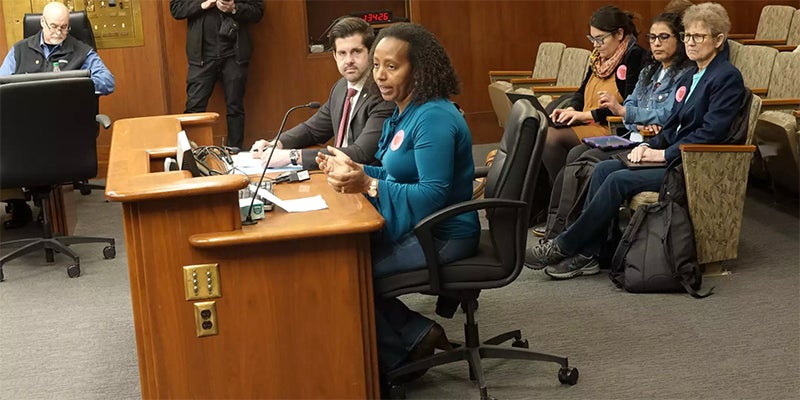Meat-plant workers lean on MN lawmakers for safety help
Published 6:49 am Thursday, February 16, 2023

- Berhane Bekele, right, testifies before a House committee on Tuesday about injuries she has sustained while working at a pork packing plant in Austin, Minn. Dana Ferguson | MPR News
|
Getting your Trinity Audio player ready...
|
Hogs on fast-moving production lines swinging and hitting employees. Sharp or heavy equipment causing deep cuts or crushed bones. Spreading sickness from working in close quarters in poorly ventilated facilities.
One meat-processing worker after another shared with lawmakers Tuesday their horror stories of witnessing or experiencing severe injuries, toiling with aching muscles from repetitive stress or reporting for long shifts in stifling and excessively loud plants.
Dan Lenway, a food plant employee for 27 years and a chief steward with the United Food and Commercial Workers union for the past six, spoke of coworkers with chemical burns, run-ins with forklifts and broken bones from faulty equipment. He said one man was working with a belly press despite voicing concerns over the soundness of safety features.
“The press got his two fingers and his thumb — 1,800 pounds of pressure in that press totally crushed it. He was stuck in that press for a half hour before they could get him out of there,” Lenway said. “He was writhing in pain. I stood there and watched the whole thing. It was unbearable. Any of these injuries could have been and can be avoided.”
He and the others were there to put personal stories behind a bill that would:
- Give industry workers greater ability to refuse work in dangerous conditions
- Afford them more whistleblower protections
- Require that employers provide more programs to prevent chronic injuries
- Add heft to regulator enforcement
- Designate an industry-focused “workers rights coordinator” within the Department of Labor and Industry
The bill got simultaneous airings Tuesday in House and Senate committees, but only the House Labor and Industry Finance Committee moved it along on an 11-2 vote.
Rep. Dan Wolgamott, DFL-St. Cloud, said the legislation builds off a packinghouse worker bill of rights enacted in 2007.
“This bill is to beef that up and to make sure that we are having the backs of the workers who are putting food on our tables,” he said.
In the Senate, bill sponsor Aric Putnam, DFL-St. Cloud, settled for discussion for now. He said he would meet with industry representatives to address their concerns, but stressed he won’t let worker protections be eroded.
Already, the bill has changed since its introduction so that it now applies only to operations with 50 or more employees.
No company officials testified publicly.
But Tamara Nelsen, executive director of the industry-backed Minnesota AgriGrowth Council, said food producers are constantly working on improving safety conditions. She said the bill needs to be clearer about the settings it applies to because some egg production and pet food plants are more highly automated than other kinds of meat-processing operations.
“If the initiative is to protect the most workers, it should be focused on those that might be at most risk,” Nelson said to the committees. She also cautioned against having a state agency official with exclusive focus on the food industry, saying that “kind of dilutes other effectiveness in other manufacturing areas in our state.”
Claudia Ambriz, who lives in Austin, Minn., and works in a pork processing plant, said the Legislature needs to step in because regular safety meetings aren’t doing enough to head off injury. She said some workers are afraid to speak up.
“Employers don’t understand that workers need quality training,” Ambriz said. “And instead of providing that training, they let go of workers because they see labor as disposable.”
Berhane Bekele, a pork plant worker for 23 years, said she has strained muscles and has been coping with carpal tunnel in her hands. But she said she has struggled to get adequate treatment and has had to press on.
“I just had a baby and I couldn’t hold my baby,” Bekele said. “I have to use my elbows to hold my baby, and it hurts. For me that’s the worst part.”
Republican lawmakers said they too want to protect workers in the industry. But they also placed blame on government agencies for not using existing workplace safety laws to remedy the situation.
“There’s quite a bit in here. If they’re not enforcing what’s already in statute, how is this going to help?” asked Rep. Shane Mekeland, R-Clear Lake, adding later in the hearing, “A lot of this is already on the books.”
He was one of the two dissenters. Mekeland pressed Lenway on the responsiveness of state workplace regulators. The chief steward spoke of calling the state and being told of monthslong backlogs.
“If I have to find the backing of the Legislature to push OSHA and who we can to help us, that’s what we need,” Lenway said.
Minnesota’s Occupational Health and Safety Administration has about 50 workplace safety inspectors for the state, but it is slowly building that up. Labor and Industry Commissioner Nicole Blissenbach said the unit concluded 1,300 inspections, including 50 fatality investigations and responded to 10,000 email and phone inquiries the last fiscal year.
She said more staff would go a long way.
“There definitely is a strain on the amount of staff that we have in our OSHA compliance division,” Blissenbach said. “It’s hard to say how many we would need to address every safety and health hazard that exists in the entire state of Minnesota, but 50 is not enough.”




